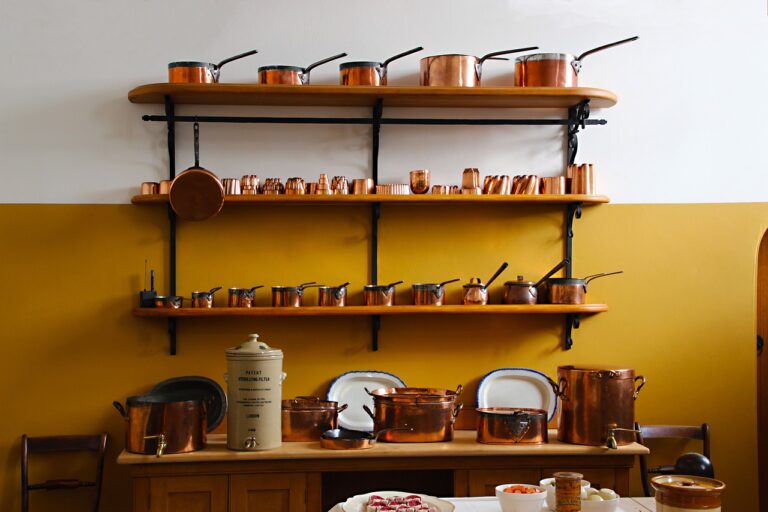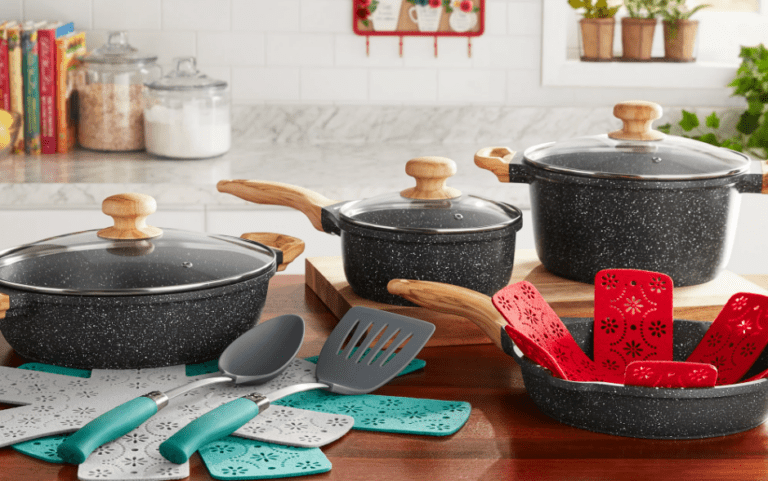As someone who’s always looking for ways to save energy and reduce my carbon footprint, I’m excited to share these kitchen efficiency hacks.
With simple adjustments, we can slash energy bills and make our kitchens more environmentally friendly.
From calculating gadget efficiency to optimizing appliances like the fridge, oven, and hob, there are plenty of practical tips to explore.
Join me as we transform our kitchens into energy-saving powerhouses without compromising functionality.
Let’s make a positive impact on our environment and our wallets.
Key Takeaways
- Consider the energy efficiency of gadgets when purchasing or using them. Gadgets with high KwH ratings but shorter usage times can be more fuel efficient, and microwave ovens are often more fuel efficient than conventional ovens.
- Regularly defrosting your freezer and keeping it full can make it more efficient. Defrost food in the fridge to lower the temperature and reduce the workload of the motor. Cool hot dishes before putting them in the fridge to avoid raising the temperature.
- Maintain efficient seals on fridges, freezers, and ovens to reduce energy consumption. Test the efficiency of door seals by shutting a folded piece of paper in the door, and repeat the test on all four sides of the appliance.
- Use energy-saving techniques when cooking with ovens and hobs. Use the smaller oven in a double oven whenever possible, cook multiple dishes at the same time, and avoid opening the oven door frequently. Use the right-sized hob ring for your pan, cook with the lid on, and only boil the amount of water you need in the kettle.
Calculating and Considering Energy Efficiency of Gadgets
When considering the energy efficiency of gadgets, it’s important to multiply the KwH rating by the number of hours needed to do its job. This calculation gives you an idea of how much energy the gadget will consume.
When shopping for new appliances, look for fuel efficient options that have lower KwH ratings and shorter usage times. This means they can do the same job while using less energy.
Additionally, consider buying second hand electrical items. Not only can this save you money, but it also reduces the carbon footprint associated with manufacturing new gadgets. Just make sure to have them professionally checked for safety before purchasing.

Freezer and Fridge Efficiency
Keeping my freezer full can help make it more efficient. Here are four ways to maximize efficiency and reduce food waste:
- Proper organization: Arrange items in an organized manner, so you can easily find what you need without wasting time and energy searching. Group similar items together and label them to avoid forgetting about food at the back.
- Use containers and bags: Store food in airtight containers or bags to prevent air from entering and causing freezer burn. This will help maintain the quality of your food and prevent unnecessary waste.
- Rotate your stock: Make sure to use older items before adding new ones. By rotating your stock, you ensure that nothing gets forgotten and wasted.
- Don’t overfill: While it’s important to keep your freezer full, don’t overfill it to the point where air can’t circulate. This can lead to inefficient cooling and potential food spoilage.
Oven Efficiency
I find that using the smaller oven in a double oven whenever possible saves energy while cooking. It’s a simple way to reduce my energy consumption and lower my utility bills.
Additionally, improving oven insulation can also help increase energy efficiency. By ensuring that the oven is properly insulated, I can prevent heat loss and maintain a consistent temperature while cooking.
Another way to improve oven efficiency is by using efficient oven cleaning techniques. Regularly cleaning the oven helps to remove any built-up grease or residue that can hinder its performance. By keeping the oven clean, I can ensure that it operates at its optimal level and uses energy more efficiently.
Overall, these small changes in oven usage and maintenance can make a significant difference in reducing energy consumption and saving money.
Hob Efficiency
Using the right-sized hob ring for my pan ensures that the energy is efficiently directed towards heating the food rather than wasting it on heating the air. This is one of the key principles of energy efficient cooking methods. Here are four reasons why using the right sized hob ring is important:
- Minimizes energy wastage: When the hob ring matches the size of the pan, the heat is concentrated on the bottom, allowing for efficient cooking and reducing energy wastage.
- Faster cooking time: By using the right-sized hob ring, the food heats up more quickly, resulting in shorter cooking times and saving energy.
- Even heat distribution: The correct hob ring size ensures even heat distribution, preventing hot spots and ensuring that the food cooks evenly.
- Safer cooking: Using the right-sized hob ring reduces the risk of accidents, such as spills or burns, as the pan is stable and properly supported.
Residual Heat Cooking
Residual heat cooking is a method that utilizes the retained heat from boiling food to continue cooking it in a box packed with hay or other insulating materials. It’s a fantastic way to save energy and reduce kitchen waste.
There are alternatives to using hay for this cooking technique, such as using old pillows or duvets as insulating materials. Another alternative is the use of Wonderbags, which are cooking bags made in Africa that allow food to cook in its own heat for up to 12 hours.
Additionally, slow cookers are another great option for residual heat cooking. They’ve a low power usage and can cook a casserole for six hours on low, costing only around 9p.
Maximizing Microwave Efficiency
When using a microwave, I find that covering the food with a microwave-safe lid or microwave-safe plastic wrap helps to trap steam and maximize efficiency. This not only reduces cooking time but also helps to retain the moisture and nutrients in the food.
Additionally, here are four best microwave cooking practices to consider for reducing microwave emissions and improving efficiency:
- Use microwave-safe containers: Ensure that the containers you use are specifically designed for microwave use to prevent any harmful chemicals from leaching into your food.
- Cut food into smaller pieces: By cutting food into smaller, uniform pieces, you can ensure more even cooking and reduce the cooking time, thus saving energy.
- Stir and rotate: Stirring and rotating the food during cooking can help distribute heat more evenly and prevent hot spots, resulting in more efficient cooking.
- Use the appropriate power level: Adjusting the power level based on the type of food being cooked can help prevent overcooking and unnecessary energy consumption.
Choosing Energy-Efficient Appliances
When it comes to choosing appliances for my kitchen, I always prioritize energy efficiency. Energy efficient appliances not only help me save on my energy bills, but they also contribute to a greener and more sustainable lifestyle.
With advancements in energy saving technology, there are now plenty of options available that are both efficient and high-performing. From refrigerators with smart cooling systems to dishwashers with water-saving features, energy efficient appliances are designed to minimize energy consumption without compromising on functionality.
Not only do they have a positive impact on the environment, but they also provide long-term cost savings. So, whenever I’m in the market for a new appliance, I make sure to look for the Energy Star label and read up on the energy efficiency ratings to make the best choice for my kitchen and the planet.
Proper Maintenance for Energy Savings
Maintaining my appliances through regular maintenance and cleaning is essential for maximizing energy savings and prolonging their lifespan.
Here are some energy-saving tips for kitchen appliances that I follow:
- Clean the refrigerator coils: Dust and debris can accumulate on the coils, making the fridge work harder to cool down. By cleaning them regularly, I ensure optimal efficiency.
- Use the dishwasher efficiently: I always wait until I have a full load before running the dishwasher. Additionally, I use the energy-saving mode and air dry option to reduce energy consumption.
- Optimize oven usage: Preheating the oven only when necessary and using the oven light to check on food instead of opening the door can help conserve energy.
- Unplug small appliances when not in use: Many kitchen appliances continue to draw power even when not in use. By unplugging them, I eliminate these energy vampires and reduce energy consumption in the kitchen.
Smart Cooking Techniques for Energy Efficiency
I find that using residual heat cooking techniques, like haybox cooking or using a Wonderbag, can significantly reduce energy consumption in the kitchen. These smart cooking techniques allow me to save energy while still preparing delicious meals.
With haybox cooking, I simply bring the food to a boil, cover it tightly, and place it in a box packed with hay. The residual heat continues to cook the food, eliminating the need for additional energy.
The Wonderbag, on the other hand, is a cooking bag that allows food to cook in its own heat for up to 12 hours.
Energy-Saving Tips for Small Kitchen Appliances
Using energy-efficient small kitchen appliances can help me reduce my electricity usage and save money. Here are four ways I can maximize the efficiency of my small kitchen appliances:
- Reduce standby power: Unplug small kitchen appliances when they aren’t in use to eliminate standby power consumption. Standby power can account for up to 10% of a household’s energy usage.
- Use appliances efficiently: Follow the manufacturer’s instructions for proper use of appliances. Avoid overloading appliances and use the appropriate settings for different tasks. This ensures that appliances operate at their optimal efficiency.
- Choose energy-efficient appliances: Look for appliances with the Energy Star label, which indicates that they meet strict energy efficiency standards. These appliances consume less energy and can significantly reduce electricity bills.
- Maintain appliances regularly: Keep appliances clean and well-maintained to ensure they operate efficiently. Regularly clean filters, vents, and coils to prevent dust build-up, which can reduce their efficiency.
Efficient Water Usage in the Kitchen
To conserve water in the kitchen, it’s important to be mindful of how much water is being used when washing dishes and rinsing fruits and vegetables. Reducing water waste can be achieved by implementing water saving techniques.
For example, instead of letting the water run continuously while washing dishes, I fill up the sink with soapy water and only turn on the faucet when rinsing. This saves a significant amount of water.
When rinsing fruits and vegetables, I use a colander or a bowl instead of running them under a constant stream of water.
Additionally, I make sure to fix any leaky faucets or pipes in the kitchen to prevent unnecessary water loss.
Lighting and Ventilation Tips for Energy Conservation
Switching to energy-efficient LED light bulbs and utilizing natural lighting through open windows can help reduce energy consumption in the kitchen. Here are some tips to improve your kitchen’s lighting and ventilation:
- Install energy-efficient lighting options such as LED bulbs, which use less electricity and last longer than traditional incandescent bulbs.
- Use natural lighting by opening windows during the day to reduce the need for artificial lighting.
- Install range hoods or exhaust fans to improve kitchen ventilation and remove cooking odors and pollutants.
- Consider installing skylights or light tubes to bring in more natural light and reduce the need for artificial lighting during the day.
Frequently Asked Questions
How Can I Determine the Energy Efficiency of a Kitchen Gadget Before Purchasing It?
To determine the energy efficiency of a kitchen gadget before buying, multiply the KwH rating by usage hours and the cost per KwH. High KwH ratings with shorter usage times can be more efficient.
What Are Some Tips for Maximizing the Energy Efficiency of a Microwave Oven?
To maximize microwave efficiency and reduce energy consumption, I recommend using it for shorter periods, choosing a model with a high energy rating, and avoiding unnecessary preheating. These simple steps can help slash energy bills.
Are There Any Specific Cooking Techniques That Can Help Save Energy in the Kitchen?
There are several energy-saving cooking techniques that can help reduce energy consumption in the kitchen. Additionally, using eco-friendly kitchen appliances can contribute to a more sustainable and efficient cooking process.
What Are Some Energy-Saving Tips for Small Kitchen Appliances Like Blenders and Toasters?
Some energy-saving tips for small kitchen appliances like blenders and toasters are using them efficiently, unplugging when not in use, and opting for energy-efficient models. These tips can help save energy and reduce electricity bills.
How Can I Reduce Energy Consumption in the Kitchen Through Efficient Water Usage?
To reduce energy consumption in the kitchen through efficient water usage, I can implement water-saving techniques like using a dishwasher instead of hand-washing dishes, ensuring it’s fully loaded, and using the eco-friendly or energy-saving mode.
Conclusion
In conclusion, by implementing these kitchen efficiency hacks, we can greatly reduce our energy bills and minimize our carbon footprint.
From choosing energy-efficient gadgets to optimizing the performance of our appliances, there are numerous ways to make our kitchens more environmentally friendly without sacrificing functionality.
By adopting these practices, we can make a positive impact on both our environment and our wallets.
Let’s all take steps towards a more energy-efficient future.


